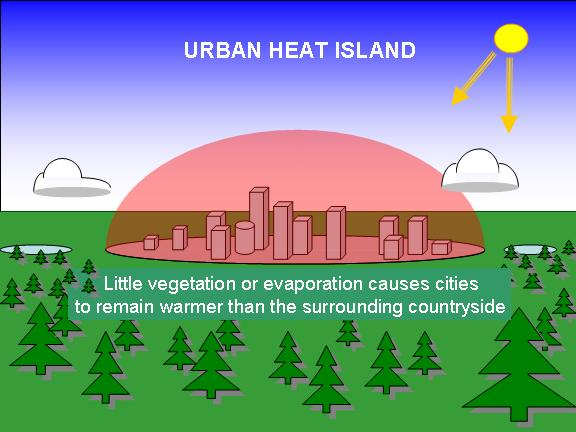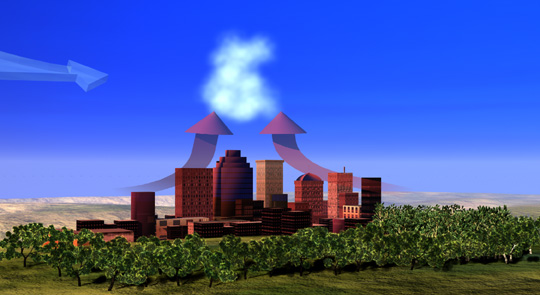|
Land Use Changes
>> Primary effect is on how water is
cycled
>> Forests retain water
The way land is used has a drastic
impact on how water is cycled in our atmosphere. For example, a forested
area of the planet retains water fairly well. This water retention in
these areas leads to increased evaporation and transpiration. In addition
to the increase in evaporation and transpiration, less runoff occurs throughout
forested areas and, therefore, more water is put back into the local atmosphere.
Urban Heat Island
>> The inner city is almost always
warmer than the surrounding countryside
>> The difference in temperature between the two areas usually increases as the
population of the city increases
>> Surface Characteristics
|
 |
|
Figure 1:
The image above illustrates the concept of the urban heat island.
|
The urban heat island effect is due in
part to some of the characteristics of the various surfaces found throughout a
city. In general these surfaces have a much higher heat capacity which
allows them to absorb and store more solar energy. In addition to the
increased absorption of solar radiation by these materials, the surface area
that these materials covered is also much greater. The large amount of
surface area allows for a greater opportunity to absorb reflected solar
radiation and it causes infrared radiation to be emitted from a much larger
area. Finally, rooftops and road surfaces are usually dark in color, resulting
in additional absorption of solar radiation. The combination of all these factors leads to the creation of an
urban heat island. Figure 1, found to the right, illustrates the
urban heat island effect.
>> Emissions
In addition to the surface
characteristics mentioned above, the large increase in urban emissions also
plays a part in the creation of an urban heat island. The abundance of
automobiles, factories, and people throughout urban areas allows for massive heat
production and release.
>> Water Cycling
Probably the most important factor that helps to
create an urban heat island is the way water is cycled, as
mentioned above. Unlike rural areas, the precipitation that occurs in
cities isn't readily absorbed by the ground as it is mostly made up of man-made
materials. This allows the precipitation that falls in urban areas to runoff at
a rapid pace. Since little water is absorbed into the ground or remains on the surface
throughout the city, less of the incoming solar energy is used to evaporate
the water. Because evaporation is a cooling process, this allows a good majority of the solar energy to work to heat
the various surfaces throughout the city.
Enhanced Precipitation
>> This usually occurs only in the
largest cities
>> Convection
Precipitation can be enhanced in the
largest cities due to the urban heat island effect. This enhanced
precipitation is a direct result of the hotter air in the city being
more buoyant than the surrounding rural air. This causes the air in the
city to rise.
>> Convergence
The convective motions that occur as a
result of the warmer urban air cause the surrounding rural air to
flow into the city. In addition, once the air reaches the rougher urban surfaces, the
incoming winds slow. This frictional convergence also leads to rising air.
>> Aerosols
The increased pollution found in urban
areas also may play a role in the enhanced precipitation found in these areas.
Since there is more pollution in these urban areas, there are many more aerosols
found throughout the air. These aerosols can be easily used as more cloud
condensation nuclei once convection has begun.
The concept of enhanced urban
precipitation can be seen in Figure 2 below.
|
 |
|
Figure 2:
The image above shows how the urban heat island effect enhances the
precipitation in and around cities. Notice that the warm air in the
city rises, cools and condenses using the aerosols from the increased
emissions in the city as cloud condensation nuclei. |
|